
Caution: The carb-conscious eaters need not read further.
Although there is much sophistication when it comes to Chinese cuisine and its myriad regional varieties and specialties, it is always puzzling to me that there seems to be so little knowledge about the fabulous phenomena that is the
Korean Chinese food. This is as distinct from authentic Chinese food as Chop Suey, which I'm sure I've never had, or fortune cookies. It is likely, however, that at least some of the Chinese restaurants you've visited in the U.S. do serve some Korean Chinese specialties but you just didn't know it. And if you can't distinguish real Chinese food from American Chinese food, you have a long, long way to go. No offense, but it's true.
Taking its base from the Mandarin Chinese cuisine, the Korean Chinese cuisine was probably developed by Chinese restaurateurs in North Korea. North Korea because of the prevalence of noddle dishes and you know those North Koreans and their noodles. In fact, the most common staples of the Korean Chinese cuisine are the various versions of noodle dishes, such as the ubiquitous
jjajangmyun and
jjamppong or the less commonly orderd gismyun or oolmyun.
A note: I will use the common romanization of these terms but they don't really tell you how they sound. It's an archaic system created by a French priest who probably didn't speak Korean well to begin with. Anyway, jja-jang-myun sounds more like tza-jang-myun and myun means noodles.
My earliest memories of the Chinese Korean food are from my childhood in Korea in the 70s. My parents would occasionally take me and my siblings out to Chinese restaurants where our father would call out for a "boy" to take our orders. It was so wrong but we thought it was very funny at that time. We always heard Chinese being spoken at these restaurants and we thought that was funny too.
At other times when we wanted jjajangmyun, we would order delivery: Yes, they had Chinese take out delivery even back then, even in Korea. Since my brothers are twins and twins were pretty rare at the time in Korea, our house was known as the "twin house" and my sister would call to order some jjajangmyun to be delivered to the "twin house." And they always knew exactly where we were. These delivery boys had, and probably still do, a special delivery container for Chinese food - it is a big box-like tin structure with shelves to hold multiple dishes - and most often they'd ride a bike to make their deliveries (they probably ride a motorbike these days or drive a car). It was a good time.
As a side note, the Chinese living in Korea are called "hwagyo."
So when my family goes out to eat Chinese, it is understood that we are going to eat Korean Chinese. There is a peculiar order to eating Korean Chinese and it is definitely not for the faint bellied.
We normally wet our appetites with jasmine tea which, I always hope, will wash down some of the oil we are about to consume. Then we get our appetizers, most commonly, fried dumplings, Shanghai-style. Shanghai-style dumplings are huge and have thick skins and you can get them steamed or fried. Then we have our "main course." Depending on the number of people at the table, we order 3-4 main dishes that we call "yori." "Yori" doesn't mean main dish. It just means prepared dish or fancy meal. Last Sunday, we ordered kanpoonggi (spicy fried chicken with bones), tangsooyook (sweet and sour beef), orange chicken (for my sister-in-law who only eats chicken, American style), and fried rice (for the American-palated children at the table). Other dishes we commonly order are nansajansa (which are like meat patties in hoisin sauce that my brother-in-law likes and the rest of my family looks down upon) or ryusansa (cut veggies with cuttlefish gelatin in mustard sauce).
You might think the meal is over by now, but wait, there's more and it's even more substantial. To wash down the "yori," as my parents would say, we order the noodle dishes, Jjajangmyun (noodles with black bean sauce) or jjamppong (which means hodge-podge or mishmash - noodles in spicy seafood broth). If you're like my father, you order a jumbo size of the noodle dish.
The jjajang or the black bean sauce, can be made in several different ways and you can ask for it on the side of the noodles instead of on top. That's a version called "Samsun" jjajang with seafood, and there's also the one that is made from jjajang powder but I forget the name. The black bean sauce is made with pork, onions and zucchini and topped with thinly sliced cucumbers to give it a zolt of coolness.
Of course, the mark of a good noodle dish is the noodles and few places can boast of making their own noodles and by hand. If you've ever seen people draw noodles by hand, it's pretty amazing. How they are able to separate a clump of dough into spectacularly long and individual noodle strings is wildly beyond me.
Somehow, almost miraculously, after all the "yori" we've consumed, there's always room for the noodles. My mother, for whom nobody can eat enough, always says, "It's only noodles. It'll go down very quickly." Obviously, she wouldn't be a good candidate for Atkins. What do French say? L'appetit vient en mangeant?
One saving grace about this experience is that there isn't a rich dessert that follows the noodles. Unless you go to a pastry shop elsewhere. Most often, we are served small amounts of sliced oranges or caramelized sweet potatoes as a sweet aftermath to the carnage of the massive meal that lay in front of us.
If you're hungry, there's nothing better and if you like noodles, there's nothing better either. If you are by yourself or someone with small stomach, I'd go easy on the "yori" and share the noodles with your companion. Or, there's always the takeout box.
In Koreatown, you can get good jjajangmyun at
YongGung on Vermont, 1 block north of Olympic, or
Great Wall on Olympic (food can be a little greasy) or
Jinhunggak in Koreatown Plaza on Western and 9th. In San Fernando Valley, we go to
Cafe Mandarin on 20425 Sherman Way in Canoga Park.
 Today, I asked my mother to make mochi. She seemed rather surprised that I asked her to make anything since I never really ask. I just eat whatever is there in her house and there's always plenty. Isn't that what parents are for, anyway? She was very obliging as she always is with any culinary requests and took out the rice cake maker. She asked me if I wanted to take the rice cake maker that my grandmother (my father's mother) used to use before she passed away two years ago. My grandfather, currently in the process of moving, gave it away and my mother already has one. I am taking it, of course.
Today, I asked my mother to make mochi. She seemed rather surprised that I asked her to make anything since I never really ask. I just eat whatever is there in her house and there's always plenty. Isn't that what parents are for, anyway? She was very obliging as she always is with any culinary requests and took out the rice cake maker. She asked me if I wanted to take the rice cake maker that my grandmother (my father's mother) used to use before she passed away two years ago. My grandfather, currently in the process of moving, gave it away and my mother already has one. I am taking it, of course. Here's the rice cake maker. My grandmother was very fond of making rice cakes with brown rice. It's a Japanese model and my parents are very thankful for this clever invention. First, you have to soak sweet rice in water for several hours to loosen it up. When the sweet rice is bloated, you put it in the machine and let it do the work.
Here's the rice cake maker. My grandmother was very fond of making rice cakes with brown rice. It's a Japanese model and my parents are very thankful for this clever invention. First, you have to soak sweet rice in water for several hours to loosen it up. When the sweet rice is bloated, you put it in the machine and let it do the work.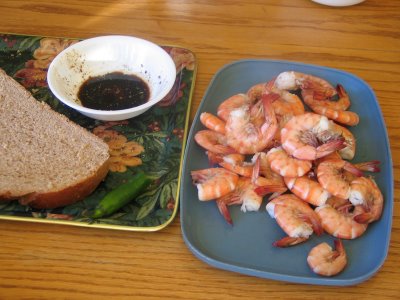 While we were waiting for the machine to do the work, my father came in with wheat bread from Great Harvest Bread Company which opened up last year in the neighborhood. He ate it with garlic olive oil and balsamic vinegar dipping sauce. M and I were familiar with the Great Harvest bread from our days in Michigan and we were really happy when they opened a store here. The bread tends to be a bit soft but who doesn't love soft bread? We also had shrimp that my parents had brought back from their recent trip to San Felipe, Mexico. The shrimp had been frozen at its most fresh stage so it retained its fresh flavor. My mother steamed them and we sprinkled a bit of lemon before we peeled the skin off.
While we were waiting for the machine to do the work, my father came in with wheat bread from Great Harvest Bread Company which opened up last year in the neighborhood. He ate it with garlic olive oil and balsamic vinegar dipping sauce. M and I were familiar with the Great Harvest bread from our days in Michigan and we were really happy when they opened a store here. The bread tends to be a bit soft but who doesn't love soft bread? We also had shrimp that my parents had brought back from their recent trip to San Felipe, Mexico. The shrimp had been frozen at its most fresh stage so it retained its fresh flavor. My mother steamed them and we sprinkled a bit of lemon before we peeled the skin off. The machine beeps when it is ready to knead the rice. The rice becomes a doughy clump and gets spinned around in the machine. Kids, including my niece, just love looking at this process. The movement is fast and jerky yet sensuous. Kids have no idea. I hope.
The machine beeps when it is ready to knead the rice. The rice becomes a doughy clump and gets spinned around in the machine. Kids, including my niece, just love looking at this process. The movement is fast and jerky yet sensuous. Kids have no idea. I hope. Anko from a can. To make it from scrach, you'd have to bloat and boil red bean and add sugar. For a very, very long time. I like anko with whole red beans instead of smooth paste but everybody's different.
Anko from a can. To make it from scrach, you'd have to bloat and boil red bean and add sugar. For a very, very long time. I like anko with whole red beans instead of smooth paste but everybody's different. Form a little ball with anko inside. The dough is very sticky so we use potato starch to cover the ball. It helps to have small but firm hands. These belong to my niece, who insists on being part of the assembly line cooking adventures at my mother's table.
Form a little ball with anko inside. The dough is very sticky so we use potato starch to cover the ball. It helps to have small but firm hands. These belong to my niece, who insists on being part of the assembly line cooking adventures at my mother's table.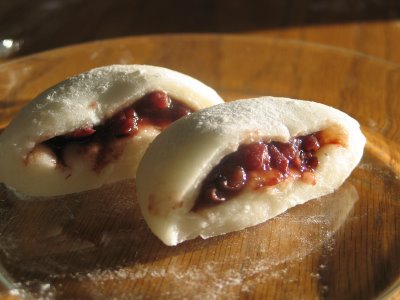 Et voila!
Et voila!



 And did you know, Filipinos taste better after one hour in the fridge!
And did you know, Filipinos taste better after one hour in the fridge!


 Yeah, this sign. No Nadar. What was this guy thinking? A brave soul or an act of stupidity? I'll imagine that he's a kindhearted soul who was so taken with the beauty of the ocean that he had to experience it, become intimate with it. As I was coming back from the pier, I saw him again. This time, he was a little closer and less poetic.
Yeah, this sign. No Nadar. What was this guy thinking? A brave soul or an act of stupidity? I'll imagine that he's a kindhearted soul who was so taken with the beauty of the ocean that he had to experience it, become intimate with it. As I was coming back from the pier, I saw him again. This time, he was a little closer and less poetic.  Yik!
Yik!
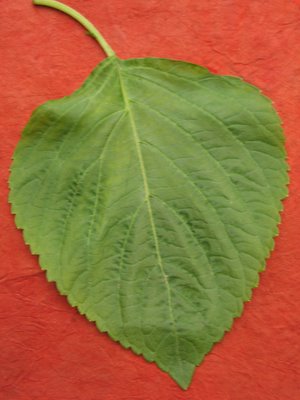
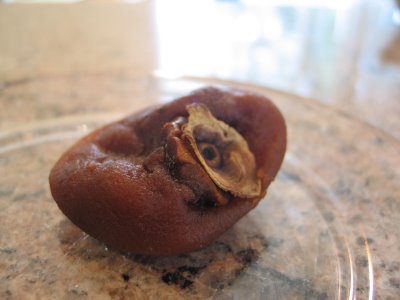


 And no one to play the queen.
And no one to play the queen. 
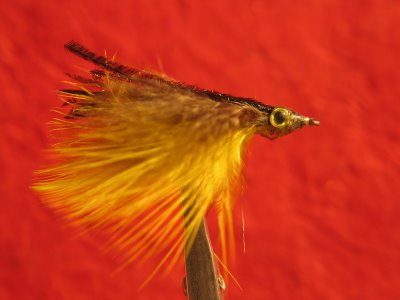 But through all these events, our fishing involved the use of artificial lures or live worms and waiting and more waiting. Never had I been exposed to the idea of casting, flies, or beautiful locations à la A River Runs Through It. And, never, ever had my family been exposed to the idea of catch-and-release: For us, fishing meant catch-and-eat. So it came as a pleasant surprise for me to learn that there was this sphere of recreational fishing that was so different from the world I used to know and I must thank M. for introducing me to it. I think M. learned to fish in Maryland and in West Virginia when he was young but it was in Connecticut during his undergraduate years that this occasional interest of his became a full-fledged devotion in his life. I can't say that I share this devotion, just yet, but I do find his interest interesting and look upon it with mild affection. Oops, I meant loving. Really.
But through all these events, our fishing involved the use of artificial lures or live worms and waiting and more waiting. Never had I been exposed to the idea of casting, flies, or beautiful locations à la A River Runs Through It. And, never, ever had my family been exposed to the idea of catch-and-release: For us, fishing meant catch-and-eat. So it came as a pleasant surprise for me to learn that there was this sphere of recreational fishing that was so different from the world I used to know and I must thank M. for introducing me to it. I think M. learned to fish in Maryland and in West Virginia when he was young but it was in Connecticut during his undergraduate years that this occasional interest of his became a full-fledged devotion in his life. I can't say that I share this devotion, just yet, but I do find his interest interesting and look upon it with mild affection. Oops, I meant loving. Really.
 So here's the dish on the Pacific Fish Center. The other crab place, Oceanside Seafood, is really no different from the Pacific but I prefer Pacific's decor. Oceanside is reminiscent of a casual beachside joint but the Pacific has wooden tables with a somewhat cozier ambience. Some people swear by one or the other, mostly on the taste of the Korean hot fish stew served after the crab but on that score I find both fish stews pretty bad, except their spiciness is the only antidote to the cholesterol of the crab meat. The only reason to go to these places is to have crabs, live shrimps, and sashimi.
So here's the dish on the Pacific Fish Center. The other crab place, Oceanside Seafood, is really no different from the Pacific but I prefer Pacific's decor. Oceanside is reminiscent of a casual beachside joint but the Pacific has wooden tables with a somewhat cozier ambience. Some people swear by one or the other, mostly on the taste of the Korean hot fish stew served after the crab but on that score I find both fish stews pretty bad, except their spiciness is the only antidote to the cholesterol of the crab meat. The only reason to go to these places is to have crabs, live shrimps, and sashimi. 

 I like chewing on these rice sticks by themselves. A thin coat of sugar makes it a sweet snack. To make Duk-gook, start with a beef stock. I prefer anchovy soub base, though. Put cut scallions, zucchini, onions and/or potatoes, salt and pepper into the soup and continue to boil. Add sliced rice cakes until they are tender. Beat eggs and drop them into the soup. Serve hot. Add dry seaweed for flavor, if desired. Happy New Year and go blue
I like chewing on these rice sticks by themselves. A thin coat of sugar makes it a sweet snack. To make Duk-gook, start with a beef stock. I prefer anchovy soub base, though. Put cut scallions, zucchini, onions and/or potatoes, salt and pepper into the soup and continue to boil. Add sliced rice cakes until they are tender. Beat eggs and drop them into the soup. Serve hot. Add dry seaweed for flavor, if desired. Happy New Year and go blue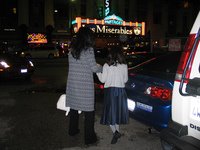 Here my sister and Lauren, our French coquette. Not our cars, by the way.
Here my sister and Lauren, our French coquette. Not our cars, by the way. After all, we're in Hollywood.
After all, we're in Hollywood.